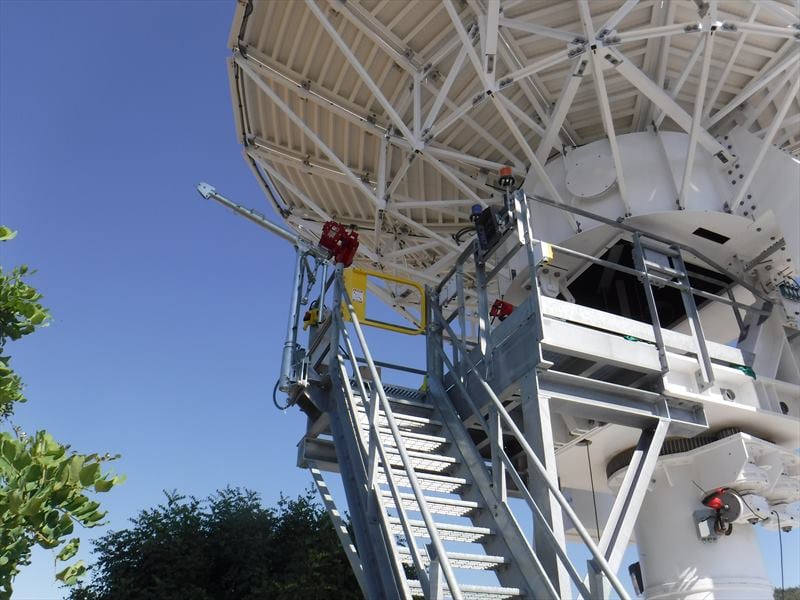Satellite communications use artificial satellites placed in the Earth's orbit to transfer information to different points across the globe, but how do they actually work?
Insight | Space Explained: What is a satellite ground station?
Space Explained: What is a satellite ground station?
- Providing global communications isn’t just about putting satellites into space. We have ground stations throughout the world which are essential for keeping the network operational every second of every day: providing a link between our satellites and the users here on Earth.
- In this article, Felipe Del Rey, Senior TTC/IOT Engineer, explains the role of satellite ground stations and how they work around the clock to ensure that our customers are connected wherever they are – on land, at sea or in the air.
Behind the scenes: how do ground stations work?
Much of the attention in satellite telecommunications is focused upwards, towards the vastness of space. That is understandable: nothing beats the spectacle of a rocket launch or the fact that some of the most sophisticated technology ever devised is flying through the vacuum of space. But our activities on earth are just as important.
When a customer wants to connect, a signal from their terminal is sent to one of our satellites positioned in geostationary orbit: 35,786km up in space. From there, it is instantly sent to one of our ground stations. In the legacy Inmarsat network, which will be used to illustrate how ground stations operate, each such station is known as a Satellite Access Station (SAS). A SAS is a physical location on earth which houses large antennas fixed on the position of a satellite and an associated technical equipment. The function of the SAS is to receive signals, process them, and then route them to their destination. Traffic is then segregated and routed based on the underlying application - whether the user wants to connect to the internet, a landline or mobile phone, an office network, or even another terminal. All this happens in less than a second.
‘Ground station’ is in fact a broad term which can mean different things across the industry. This article refers to the relatively large stations that allow us to route traffic between our satellites and other networks and infrastructure, as opposed to the smaller terminals that are used by individuals on land, in the air, and at sea to communicate with our satellites.

Our SASs are strategically positioned around the world to connect to our Inmarsat satellites. We have at least two access stations per satellite, which gives us extra reliability, as a backup ground station can handle communication with our satellites, which increases crucial overall reliability.
Our geostationary orbit satellites revolve around the Earth in sync with the Earth’s rotation, so from the perspective of someone on the ground, they are always fixed in the same position in the sky. This is extremely useful for our SASs because they can point directly at the satellite they communicate with and stay in this position, which allows us to have 24/7 visibility and means we don’t have to switch back and forth to different satellites.
Trust the process
If you make a call on an Inmarsat satellite phone, your voice travels to a satellite 35,786 km above the equator and back down to the ground station, and from here it is routed across the globe in a complex technical process that happens quickly enough to connect a phone call.
The first step in this process is called the ‘uplink’. This is when a terminal transmits a signal - for example your voice in a phone call - from the Earth to the satellite's uplink channel. Once the signal is received by one of our Inmarsat satellites, it employs advanced technology to amplify and convert the signal.
Then comes the ‘downlink’, when the signal is transmitted from one of our satellites towards a specific ground station. Once the downlink signal has been captured, our ground stations use receivers, demodulators (which extract the information from the signal sent by the satellite), and other equipment to process and extract the data encoded in the signal. The signals are also converted from analogue to digital format, so they can be sent on to their intended destination, via physical cables, land-based infrastructure, or wireless technology.
Our satellites also enable ‘two-way’ communications. Unlike in the process above – which uses a satellite communicating with one of our ground stations and a user terminal - information can be sent to and from the same ground station or user terminal via a satellite.
What is in a ground station?
The ground stations used in the Inmarsat network are full of advanced technology for receiving and analysing signals. These include large parabolic antennas, which are shaped like dishes to accurately reflect and capture incoming signals. These antennas are designed to provide high gain and directivity, allowing for efficient signal communication with our satellites.
We also have transmitter and receiver units, which are optimised to meet the specific requirements of our Inmarsat communication protocols and frequency bands, depending on the services we’re providing. Ground stations also incorporate modems and terminal equipment to ensure compatibility between the ground stations and our communications system.
Ground stations operating within the Inmarsat network, which is now controlled by Viasat, communicate with our Network Operations Centre (or NOC, pronounced ‘knock’) in London. There, our team is responsible for the co-ordination of all network activities: constantly monitoring the ground network to ensure we stay online. Alongside the NOC, our team in our Satellite Control Centre (SCC) are also in regular contact with our satellites via our ground stations to monitor onboard processes, perform routine manoeuvres and analyse the data we receive. We also have colleagues on the ground at our Satellite Access Stations, who all play a critical role in keeping them online. This is a crucial function of our ground stations, alongside connecting our customers: they allow our teams to communicate with our satellites.
what does this mean in the real world?
Let’s take a real-life example. In May 2019 Inmarsat sponsored a team of British Royal Marine veterans to conquer Mount Everest. Because of the -55°C windchill temperatures at the summit, one of the team, named Scott, suffered frostbite to both his feet and needed emergency evacuation. The team were able to use their IsatPhone 2 to call for help. The IsatPhone sent a signal to our satellite positioned above the Indian Ocean. This signal would then have been processed and passed on to the nearest ground station available: the local national satellite gateway in India. From there, the signal (the telephone call) would have been sent to emergency services via land-based terrestrial networks. A rescue helicopter was then dispatched, and Scott was airlifted to a hospital, where he made a good recovery.
In another example, which demonstrates ‘point to point’ connectivity, let’s take a maritime vessel travelling through the Suez Canal. One of the crew members has some free time and wants to use social media to chat with family members back home.
She can connect her laptop to the vessel’s onboard satellite terminal, which sends a signal up to our satellite. This request is processed onboard the satellite, and the satellite sends a signal to our regional ground station in the Mediterranean. The ground station sends the requested signal (in this case a connection to the internet), back up to the satellite, where it is processed again and returned to the ship. All these steps occur very fast to provide a broadband connection.
About the author
Felipe Del Rey holds an Msc in Telecommunications with Business from University College London. He has worked at Viasat and, prior to its recent acquisition, Inmarsat for eight years.
As Senior Tracking, Telemetry Command and In Orbit Testing Engineer, he works with the Inmarsat satellite ground network across the globe. He and a team of expert colleagues complete rigorous in-orbit testing for all Inmarsat satellites, including the I-6 F2 satellite which launched from Cape Canaveral in February 2023.



